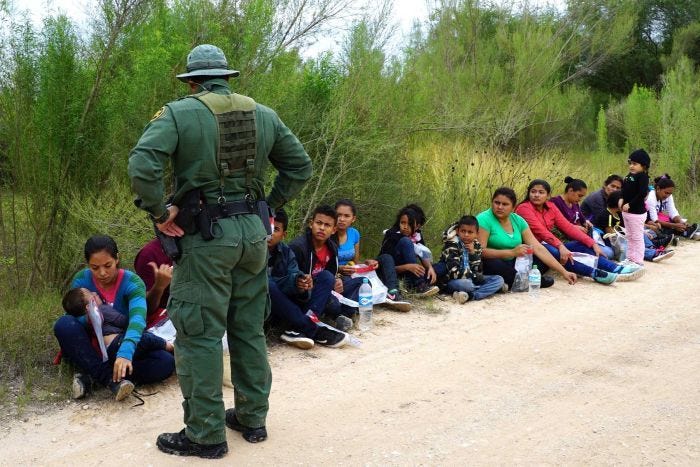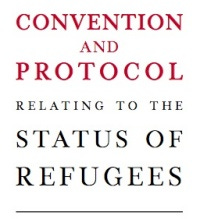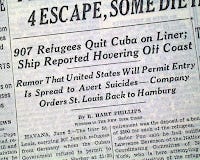In the late 1980's there was a flood of refugees from Central America--largely fleeing civil war in Nicaragua and El Salvador. As is true today, there was lots of controversy about how to respond. As a border state, Arizona was at the center of this controversy, and it was the home of the Sanctuary Movement, a church-based effort to help these refugees. I was a young lawyer in Arizona at the time, and my pastor asked me to take on two asylum cases for recent immigrants from El Salvador in deportation proceedings.
Thus began some of the most fulfilling legal cases in my career. I represented a conservative Nicaraguan family fleeing persecution from the leftist government. I represented an El Salvadoran family from a small rural community terrorized by right wing death squads. I represented a Jehovah's Witness adherent fleeing persecution in Cuba.
Perhaps my most memorable client was an El Salvadoran who was the leader of a "Base Community"--an intentional Christian community of peasants. His work led to death threats from a local death squad. What was most memorable about his case was not our efforts to get asylum--as these matters go, it was an easy case. Instead, what was most memorable was a visit to my law firm six years later by his son, who came by the office to show me his brand-new degree in engineering from ASU.
In each of these cases, my clients came across the border illegally. They really had no other option--you can only seek asylum in the United States, and at the time the Reagan Administration refused to allow Central Americans to come in the refuge program. In each case, the trip to the U.S. was harrowing and dangerous. My clients risked the dangers of travel to the US only because harm seemed certain if they stayed in El Salvador or Nicaragua.
I thought of these clients over the last few weeks as asylum seekers are once again in the news. Sadly, much of the rhetoric we are hearing from the Trump Administration and supporters of its harsh border policies displays either a fundamental misunderstanding of what asylum is all about--or a frontal attack on the very concept that we ought to take in refugees. My aim here is to explain what asylum is all about, and also make the case that taking in refugees is very much in our national interest.
First, I have heard lots of rhetoric that these asylum seekers are to be blamed because they aren't "doing it the right way." The simple answer is that there is no "other way." You can't seek asylum in El Salvador, and if you have a death threat, waiting several months even for a tourist visa or entry as a refugee to the US is really not an option if the threat is imminent. It is for this reason that both international law (in a Senate-ratified treaty known as the Convention and Protocol Relating to the Status of Refugees) and U.S. immigration law expressly state that asylum is available even if asylum seekers do not present themselves at a port of entry. They can do so at ports of entry, but they need not do so. U.S. law is very clear that even individuals who enter the U.S. without going through ports of entry are eligible to apply for asylum. The Convention (which, as a Treaty, has the same legal effect as a statute) goes even further. It provides that no nation can impose any penalty on refugees "on account of their illegal entry or presence . . . without authorization" as long as the refugee present themselves without delay to the authorities. It is for this reason that previous Administrations never criminally prosecuted asylum seekers. It is inconsistent with our obligations under international law to punish refugees.
In recent years, a much larger number of immigrants with asylum claims have presented themselves at the ports of entry, and President Biden created a mobile application process by which asylum claimants would be scheduled to enter the ports of entry. If they convince an immigration officer that they have a credible claim of asylum, they were permitted to enter the country and pursue their asylum claim. Given the crowded immigration court system, however, the hearing on the asylum claim could be years away.
The challenge is that starting in 2022 , there was a surge in asylum claims. There were 945,000 asylum claims in 2023, which was an increase of 88% over 2022. There was growing concern that the long delay in processing asylum claims was encouraging immigrants to make asylum claims as a means of entering—and remaining in the U.S. The evidence that they asylum system is being misused in recent years is indeed concerning, and the immigration court backlog is a real problem, but the response should not be to turn away even those immigrants with viable asylum claims. We should instead focus on reform and enhancement of the immigration court itself.
The Migration Policy Institute has suggested some possible reforms.
Make no mistake, an asylum claim is hard to prove--particularly for a non-English speaking Venezuelan without legal assistance. As Austin Kocher has reported, in March 1025, immigration judges denied 76% of all asylum claims—”the highest denial rate on record for any month in more than two decades.”
Behind all of this, of course, is something deeper: an apparent belief by many that we should end our asylum policy. For some, this may simply come from a lack of understanding of the conditions that cause so many to leave their homes to flee to the U.S. For others, there seems to be a belief that the burden of accepting refugees is simply more than our country can bear.
I would suggest that the answer to those who think the burden is too high is best found in our history. It is instructive to ask ourselves: When we review our nation's history of treatment of refugees, what do we regret--when we shut the door to refugees or when we left them open? Of course, the answer is obvious. To our eternal shame, we had the chance to save thousands of Jews from the Nazis, but did not.
On the other hand, our openness to refugees after World War II is both a source of pride, and evidence that refugees can greatly benefit the United States. The Cuban-American community that resulted from our acceptance of Cuban refugees after Castro took power in 1959 has been tremendously successful. The same is true of the 1.6 million refugees from Vietnam that came to the United States after the fall of Saigon. We forget that at the time polling showed very large majorities of Americans opposed the high number of Vietnamese refugees. Yet, in a relatively short time, the Vietnamese community became quite successful.
The standard for asylum is not an easy one to meet. It is only available if the person has a well-founded fear of persecution based on past persecution or risk of persecution in the future because of race, religion, nationality, membership in a particular social group or political opinion. Economic hardship (unless directed as a form of persecution) is not enough. The fact that you are fleeing violence in a war zone is not even enough unless you can show that the violence is likely to be directed at you. There must instead be a reasonable fear of persecution linked to the list of specific causes.
Perhaps it should be no surprise that those who can meet this standard do well in America. These are people who stand up for themselves and their families. We ought to continue to welcome them to America.







I once heard that the reason Trump always talks about countries sending us people from their “asylums” was an original misunderstanding when an official mentioned asylum seekers. He liked the sound of it and has kept using it.